
The Beginner’s Guide to SMS Marketing
Short message service, commonly known as “SMS” is an entirely new marketing channel that is quite literally on the brink of explosion.
Its popularity is due in part to its impressive engagement rates, ROI, and preference by consumers. Unlike email marketing, SMS allows brands to access consumers in a completely different way, sidestepping the traditional inbox and heading directly to their most personal messages, text.
It’s no secret that CAC (cost of acquisition) has been steadily increasing over the years, email engagement rates have somewhat peaked, and organic posting on social media is becoming harder to be effective with constant algorithmic changes by the social networks. All of which have tied the hands of merchants—well, at least until SMS came onto the scene.
But with a brand new marketing channel comes a lot of uncertainty and questions.
In this in-depth guide to SMS marketing, I’ll give you a comprehensive overview of all you need to get started with SMS marketing including:
- An overview of SMS basics
- Best practices for getting started
- How to measure your results and understanding key metrics
Overview of SMS
When considering where to begin with SMS, it’s important to think about how it fits into your omnichannel marketing strategy.
Due to the incredibly personal nature of SMS, it’s smart to take a very thoughtful and strategic approach, or as I like to say, an empathy-driven mindset. In practice, that means being hyper-focused on segmenting your campaigns and automations so you truly send the right message at the right time to the right person.
While you might send a blast to your entire email list once or twice a week, with SMS, you want to ask yourself if something is actually worth a weekly message to a subscriber or risk a high number of unsubscribes. The lesson here is, the more you’re able to use your existing data to make a message relevant and personalized, the better.
The Difference Between SMS vs. MMS
It’s important to acknowledge that not all text message marketing is SMS.
An SMS is a 160 character message that is sent to a mobile phone. If a brand sends a message that goes over that character count, the messages will be broken into separate messages and sent congruently.
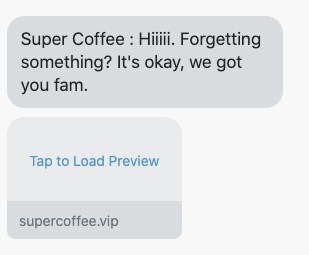
SMS abandoned cart message from Super Coffee
MMS stands for “multimedia message service” which can include up to 1600 characters and as the name suggests, can include attached media such as a photo, video, or PDF.
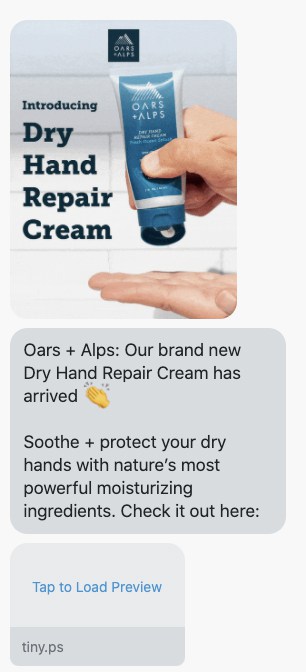
MMS campaign message from Oars & Alps
Beyond the character limits and ability to include media, these messages operate on different networks, with MMS networks occasionally having outages during peak times, like Black Friday, due to increased volume. This is due to carrier restrictions.
At the time of publication, SMS has the ability to be sent in the US, Canada, and UK, while MMS is currently only available in the US and Canada. The cost associated with sending each message typically varies as well, with MMS marketing being significantly more expensive than SMS. For the context of this guide, “SMS” will cover both SMS and MMS messages.
Short Codes vs. Long Codes
When sending SMS, there are two different types of numbers that these messages can be sent from.
The first is what’s called a long code. Long codes (for example, (675) 857-2233) were initially built for transactional (think Uber) and peer-to-peer (notifications) messaging. These messages work well for low-volume sends.
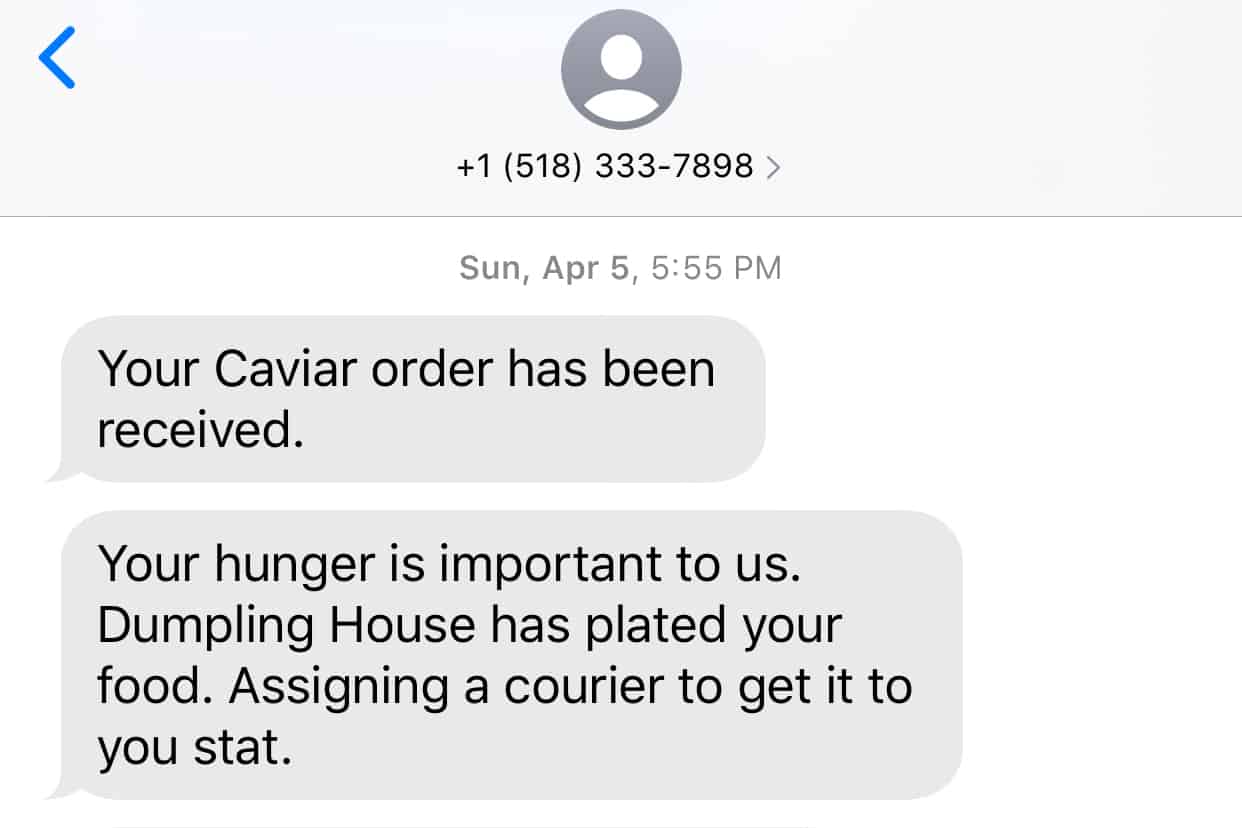
Long code message from food delivery app, Caviar
Short codes (for example, 87432) are what you typically see in marketing messages. They are built for marketing messages, which have been designated by network carriers to withstand high traffic.
Unlike email, once a carrier has designated a short code, there is no warm-up period like you would experience with an IP. The drawback for short codes is that they cost more to lease, generally $1000-$2000 per month. Some SMS marketing tools, however, do cover this cost in their billing.
Within short codes, you will find there are what’s called shared short codes and dedicated short codes.
Shared short codes, as the name implies, have many businesses use the same number. For example, you might get a notification from UPS about a package arriving and also an alert from JetBlue about an upcoming flight delay from the same shared short code. Shared short codes are in the process of being phased out by network carriers.
Dedicated short codes have been specified for a singular purpose, like ecommerce marketing.
Understanding SMS Compliance
While compliance has never been a particularly hot topic in ecommerce marketing, it is absolutely critical to understand.
If you’ve handled your email program, you’re likely familiar with GDPR (General Data Protection Regulation). SMS marketing has a completely different set of regulations in place that brands need to be familiar with.
In the United States, there are two different types of regulations that you’ll want to keep in mind.
The first is the legal side which is the Telephone Consumer Protection Act of 1991 (also known as the TCPA). The TCPA is legislation that was passed by Congress and can have large fines (up to $500/message) for violations and is increasingly being brought into class-action lawsuits.
The second important compliance to be aware of is the Cellular Telecommunications Industry Association (known as CTIA) which is the trade association run by the wireless carriers and has guidelines for using their networks. Brands can be blocked by carriers if they violate the guidelines.
I could write an entire article solely on understanding SMS compliance, but because I am not a lawyer, and not going to give any legal advice, your best course of action is to read the TCPA and CTIA guidelines.
With that said, one of the most important things to note is that every country has its own regulations, so brands should pay attention to and follow local legislation. When in doubt, following the TCPA and CTIA is best practice regardless of location as it is the strictest in the world.
Best Practices for Getting Started with SMS Marketing
Once you understand how SMS fits into your overall marketing strategy, as well as how to compliantly send, you’ll want to get up to speed on the best practices for list growth, segmenting, sending, and automating messages. Let’s dig in!
How to Grow Your Subscriber List
Growing your SMS subscriber list is critical to building out your SMS strategy. Due to the TCPA regulations, brands can only send to subscribers who explicitly opt-in to SMS messages.
Without having a clear plan in place to grow your list, your subscriber list will likely grow stale fast. Luckily, there are a few different evergreen ways you can continue to build your list, here are a few:
Passive Techniques to Grow Your List
Desktop & Mobile Pop-Up: A great top-of-funnel play, using a pop-up on your desktop and mobile site is a smart idea.
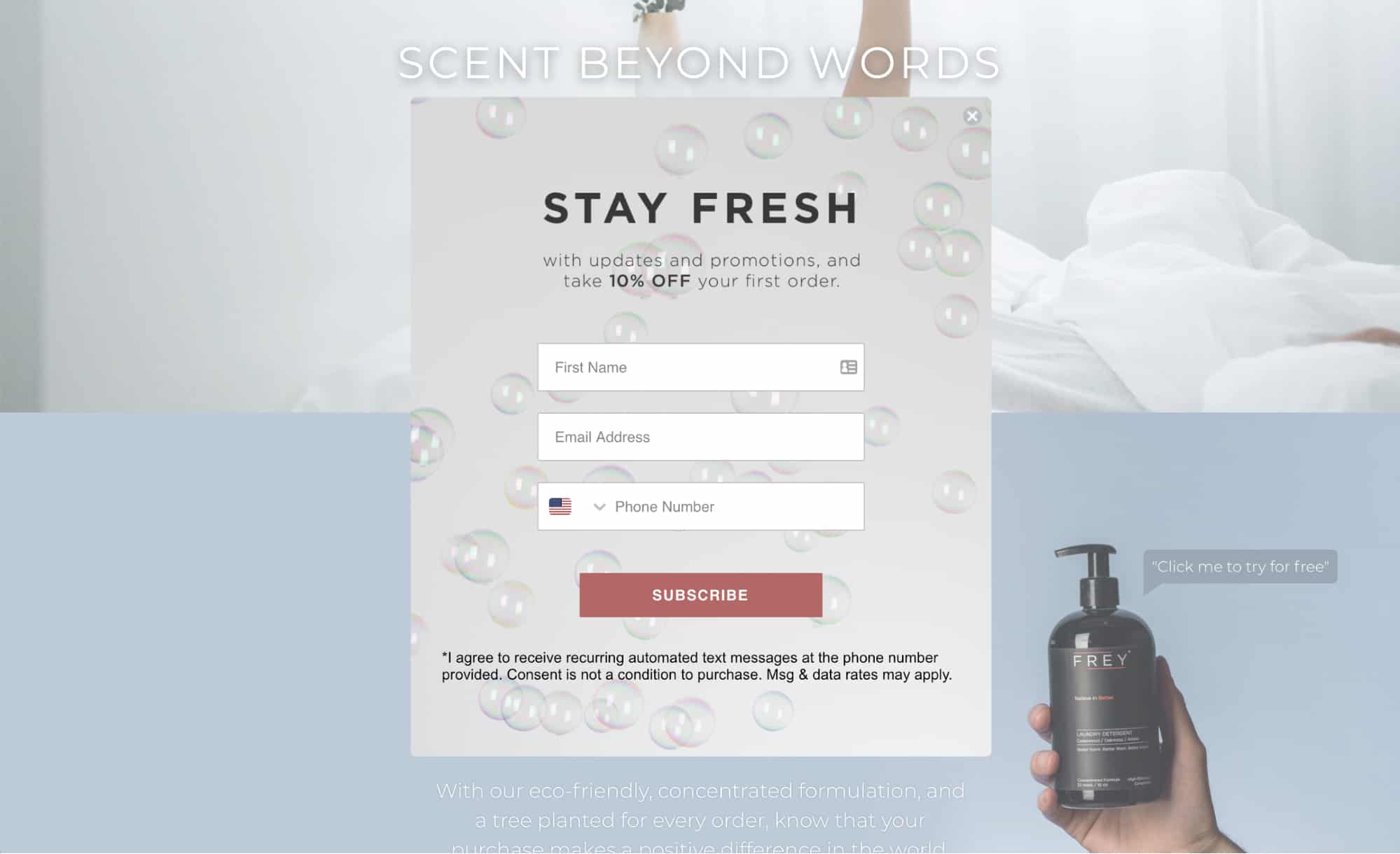
A desktop pop-up from laundry company, FREY
Some pop-up collectors (such as Privy and JustUno) allow you to create a 2-step flow that allows for both email and SMS collection if you are concerned about missing out on new email subscribers.
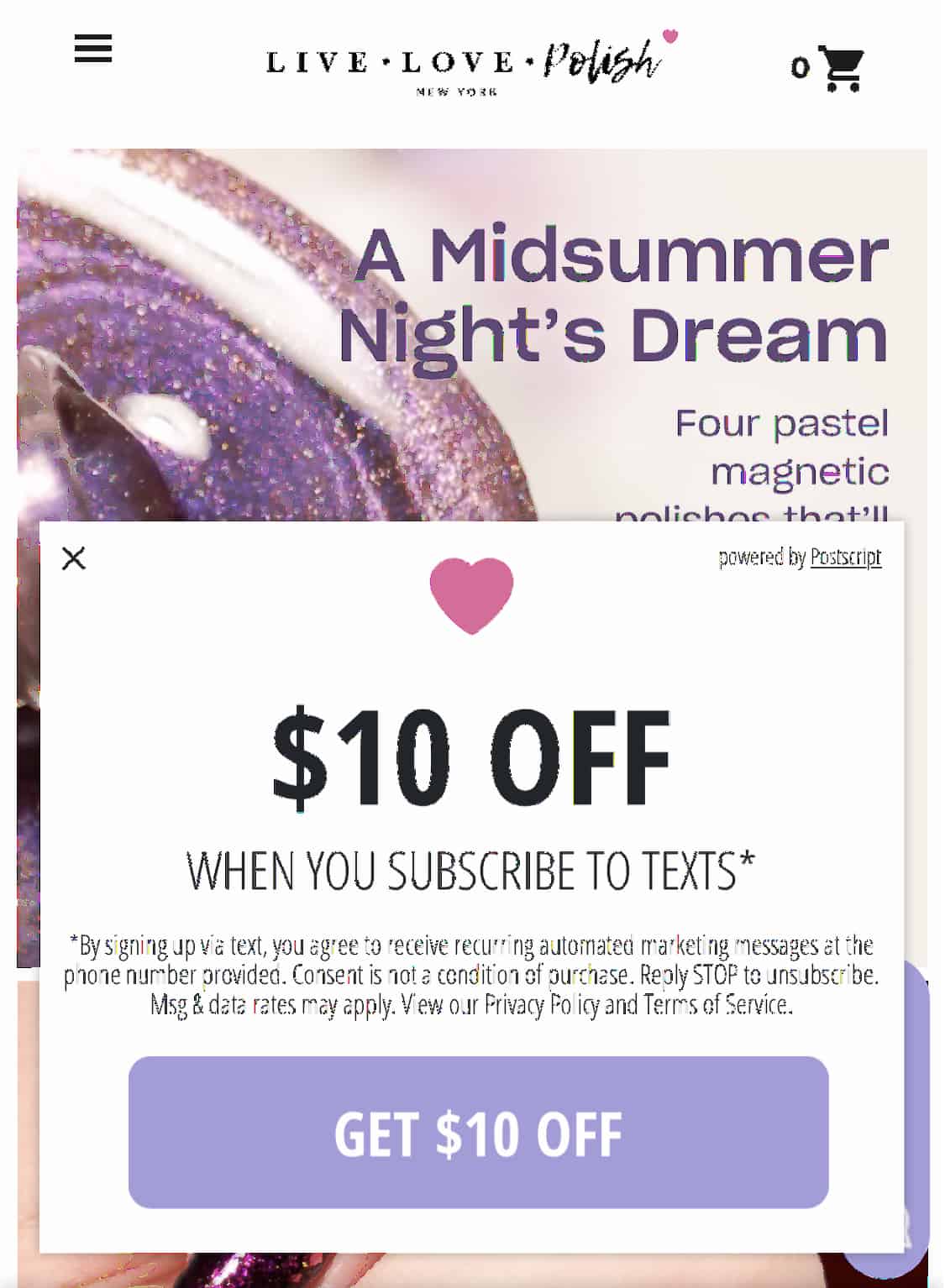
Nail polish brand, Live Love Polish uses a mobile pop-up to get new subscribers
Ideally, your mobile pop-up will automatically pull up an auto-populated text where all someone needs to do is hit send when they click on the CTA.
SMS-Compliant Checkout: If you’re a Shopify Plus merchant, you can collect compliant phone numbers by adding an unchecked box. It should be noted that this is different than normally asking for a phone number during the checkout process, which is not compliant.
Instagram Profile: Adding a keyword to your Instagram profile is another smart way to collect new subscribers.
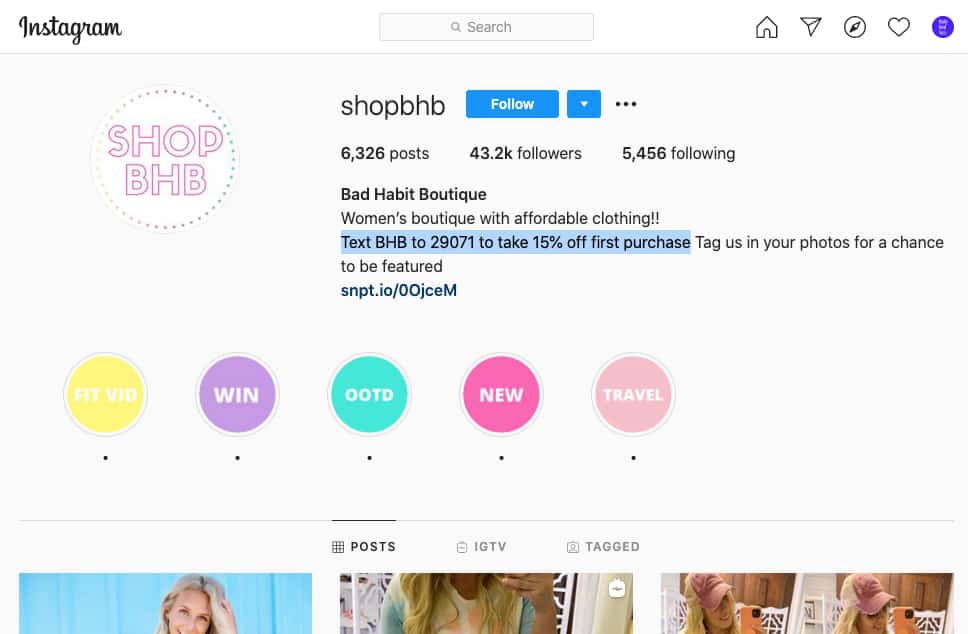
Bad Habit Boutique entices Instagram users to subscribe to SMS by including a special discount upon signing up
Use QR codes or keywords on your product packaging:
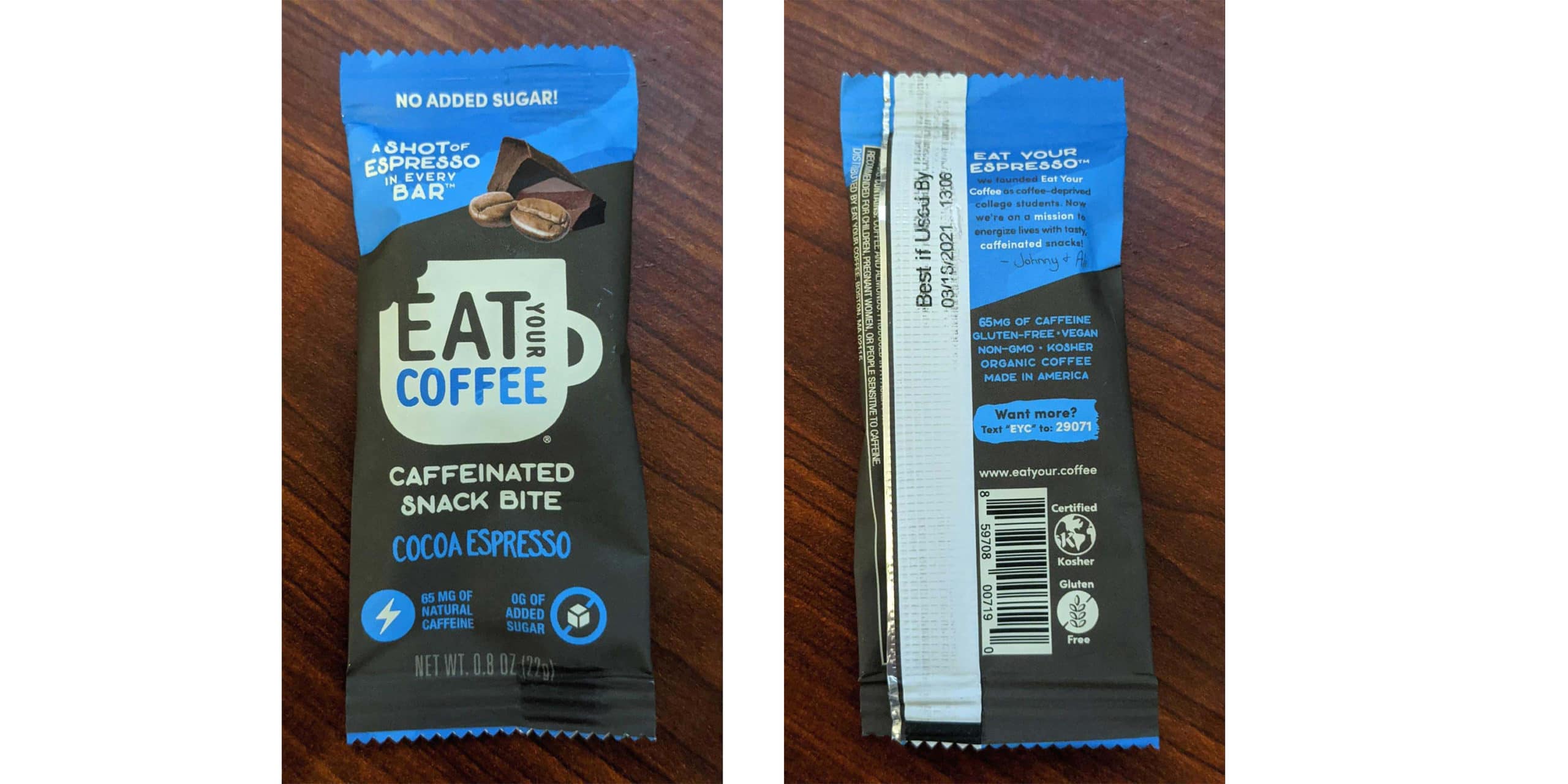
Eat Your Coffee has a CTA on the back of their wrapper to get SMS
Active Techniques to Grow Your List
Email Campaign: Building a targeted email campaign with the goal of getting email subscribers to convert into SMS subscribers is an excellent way to grow your list.

Snow teeth whitening brand, include a CTA to “Get on the List” aka signup for SMS in their welcome email campaign
“Swipe Up” on Instagram: Using the same link as a mobile pop-up opt-in, having subscribers swipe up to an auto-populated message to sign up. All users have to do is hit enter.
Instagram Post with a Keyword: Similar to adding a keyword into your Instagram profile, adding a keyword into an image is another way to actively solicit new subscribers.
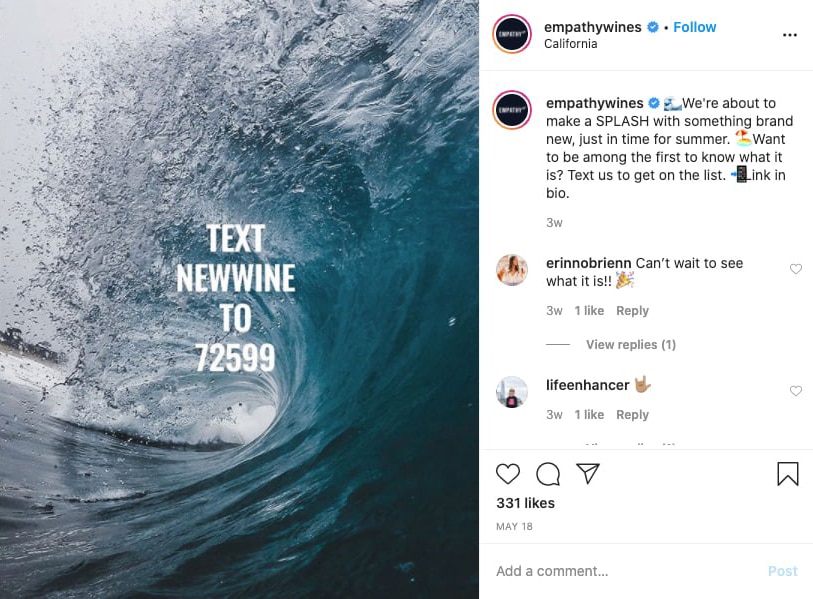
Empathy Wines adds a keyword to their Instagram post
Segmenting Your List
After you have compliantly built up your list, you can really dig in and find the magic of SMS marketing, by segmenting your subscribers. Segmenting is important to make sure you get the right message, to the right subscriber, at the right time. Ultimately, segmenting helps you to not annoy subscribers with messages that aren’t relevant to them, and it saves your brand money by sending less.
There are countless ways to segment a list, let’s look at a few of the top ways you can get started.
A/B Test
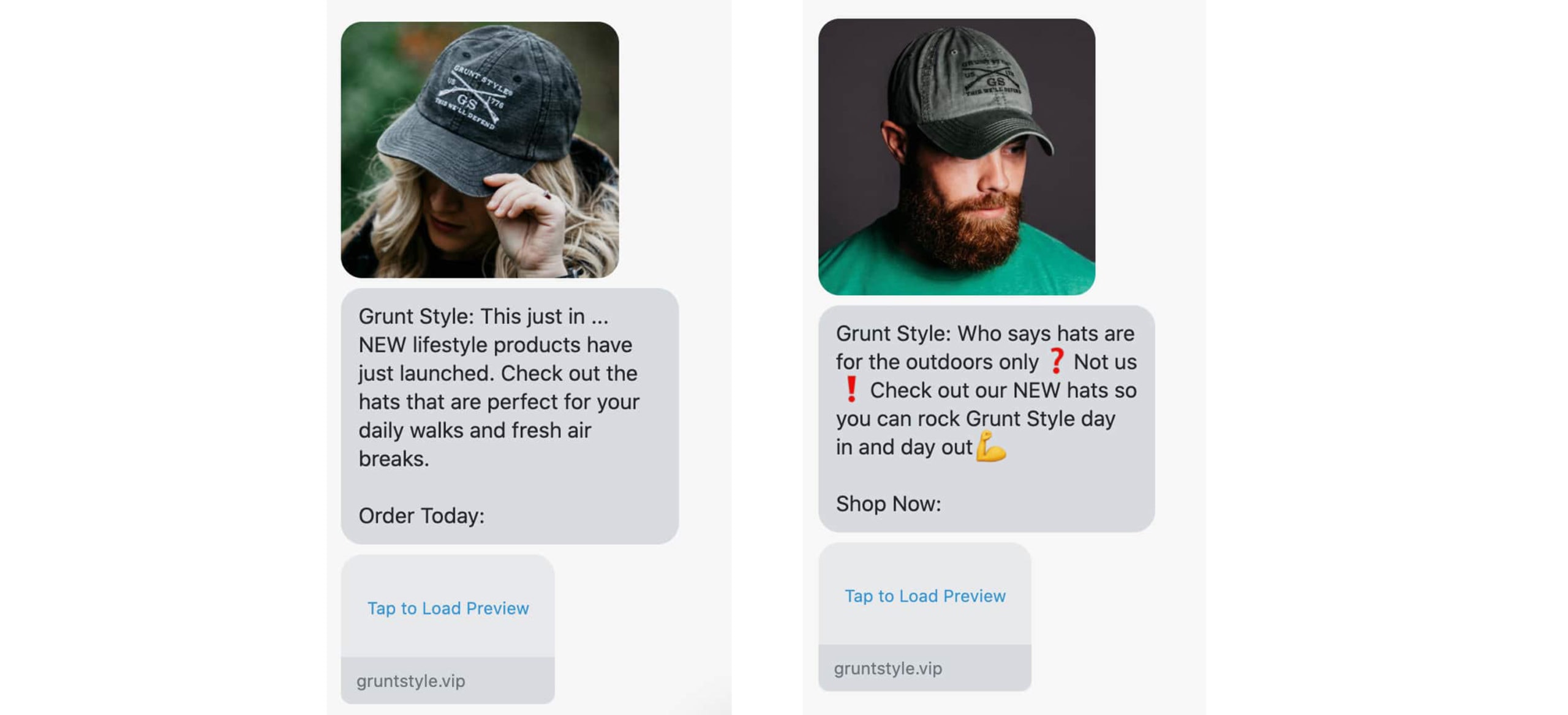
Grunt Style A/B tests images in a campaign for hats
Number of Orders (new vs. existing customers)
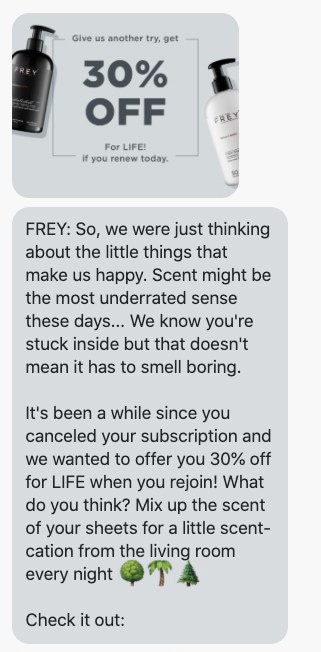
This message from FREY was sent to those who canceled a subscription
VIPs (Total amount spent, AOV, # of orders)
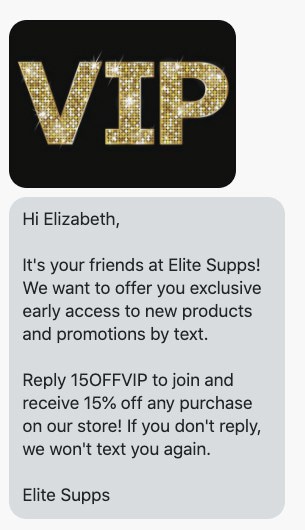
Supplement brand, Elite Supps, has dedicated messages for their VIP customers
The power of segmentation truly comes from how much data you’re able to integrate. Similar to email, some SMS providers allow you to integrate data such as subscription data and loyalty data.
SMS Campaigns
Take all your knowledge in regards to sending email campaigns, and put it to the side. In SMS marketing, the rules are completely different for campaigns. While you might send a weekly email marketing campaign, it is not recommended you take the same approach for SMS.
What to Send in SMS Campaigns
In fact, there are likely only a few times when it’s appropriate to send to your entire unsegmented SMS list.
This includes:
- New product launches

Beauty brand NaturAll Club, who specialize in hair care products made with avocado, sends an MMS to announce a new moisturizer and include a free offer
- Holiday announcements
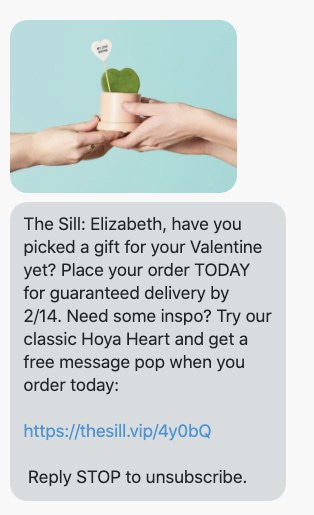
The Sill sent a timely reminder campaign for Valentines Days to subscribers
- Restock of popular items
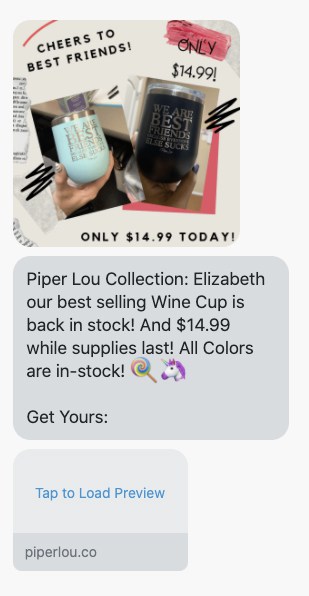
Piper Lou Collection uses SMS to notify subscribers that their best-selling wine cup is back in stock
- Generous promotions
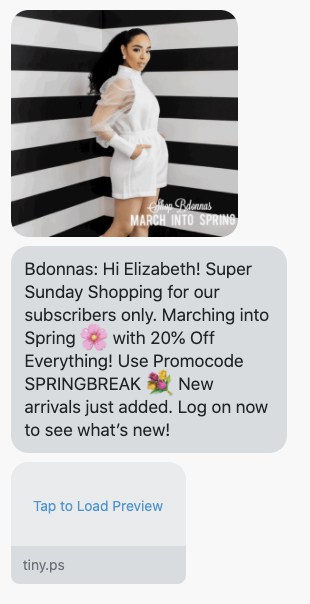
Fashion brand, Bdonnas, sends an SMS campaign for an exclusive sale open to subscribers only
A better approach is to have a wider variety of campaigns, which are segmented and filtered based on subscriber data. If you decide to do regular SMS blasts to your entire list, you’ll likely face very high unsubscribe rates and hurt your potential revenue.
When to Send Your SMS Campaigns
Finding the right time to send a campaign depends on your audience and the products that you sell. It’s incredibly subjective. There are some basic guidelines you should follow when deciding when to send.
TCPA waking hours (8 am-6 pm PST) are a good guideline of when is an appropriate time to send a text message (and avoid waking someone up in the middle of the night).
What a “Good” SMS Campaign Looks Like
What makes some campaigns a successful, delightful experience and well, other, duds? When building an SMS campaign, follow these parameters to make a great campaign.
Concise: Make sure your campaigns are clear and are not walls of text blocks.
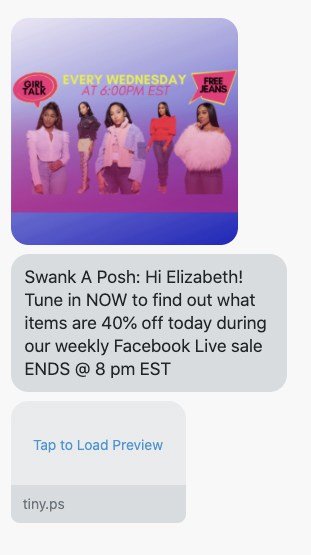
Swank a Posh keeps it short and sweet to let subscribers know about a sale during their Facebook Live sale
Include a Direct CTA: If you want subscribers to take action be very clear.
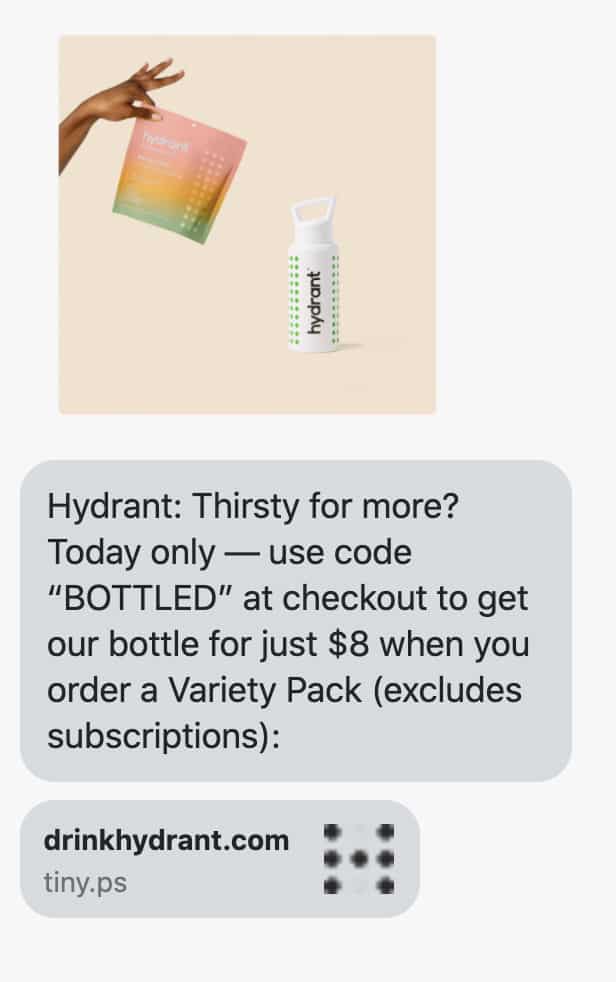
Hydrant sends a direct message to use a code, today only, for a special price
Keep it on Brand: Your SMS marketing should sound like the other customer touchpoints which use your brand voice including your website, email, and social media.

Emergency preparedness brand, Judy, provides helpful emergency preparedness tips via SMS
Embrace Emojis: Without the use of font styling and other graphic assistance, often the best way to add character and tone is by including an emoji (or three).
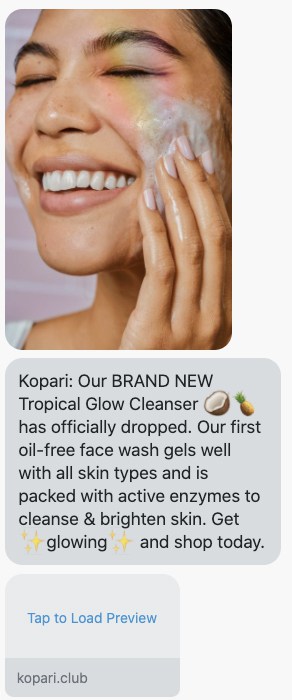
Kopari uses emojis to convey brand voice and for emphasis
For more examples of good text message marketing, you can view hundreds of examples on ReallyGoodTexts.com.
Building Out Automations
Automations are triggered-based flows, which go out when a customer takes a certain action. Unlike campaigns, automations go out selectively vs. all at once. They’re incredible tools to scale revenue because they allow you to be incredibly granular in your targeting. Similar to segments, you could build out hundreds of different automations based on different customer behavior. Over time, crafting 5-10 automations that cover the entire customer lifecycle is a solid strategy.
In addition to marketing promotions, automations are also a great tool to cut down on the number of incoming support messages you receive. For example, if you have a product that requires tricky assembly, follow up with an SMS after an order has been delivered with more details.
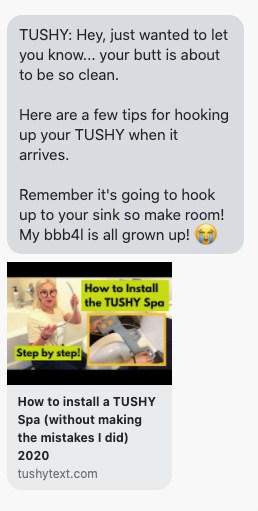
Bidet attachments brand, TUSHY, sends how-to instructions for new purchasers
When you’re first getting started with SMS marketing these are three great automations to get you up and running:
Abandoned Cart: Somewhat of a no-brainer, an abandoned cart isn’t going to make you money. Another way to improve on this automation is to build out different abandoned carts based on if someone is a new or a returning customer with different offers.
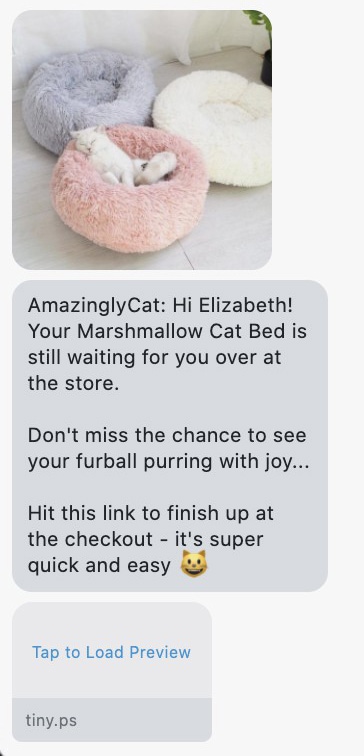
Amazingly Cat sends a “purr-fect” abandoned cart that’s helpful and fun
Welcome Series: A welcome series is a great way to introduce your brand to new subscribers and offer relevant content or offers.
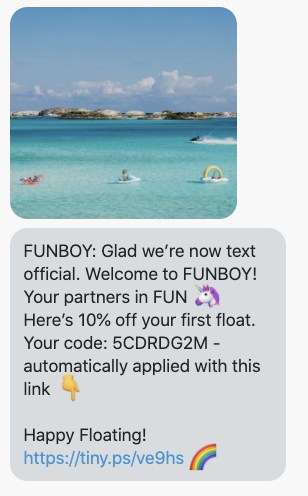
Pool float brand, Funboy, has a great welcome series that is on brand and includes a great offer for new subscribers
Post Purchase: Let buyers know their order has successfully gone through and entice them with a coupon for a future purchase.
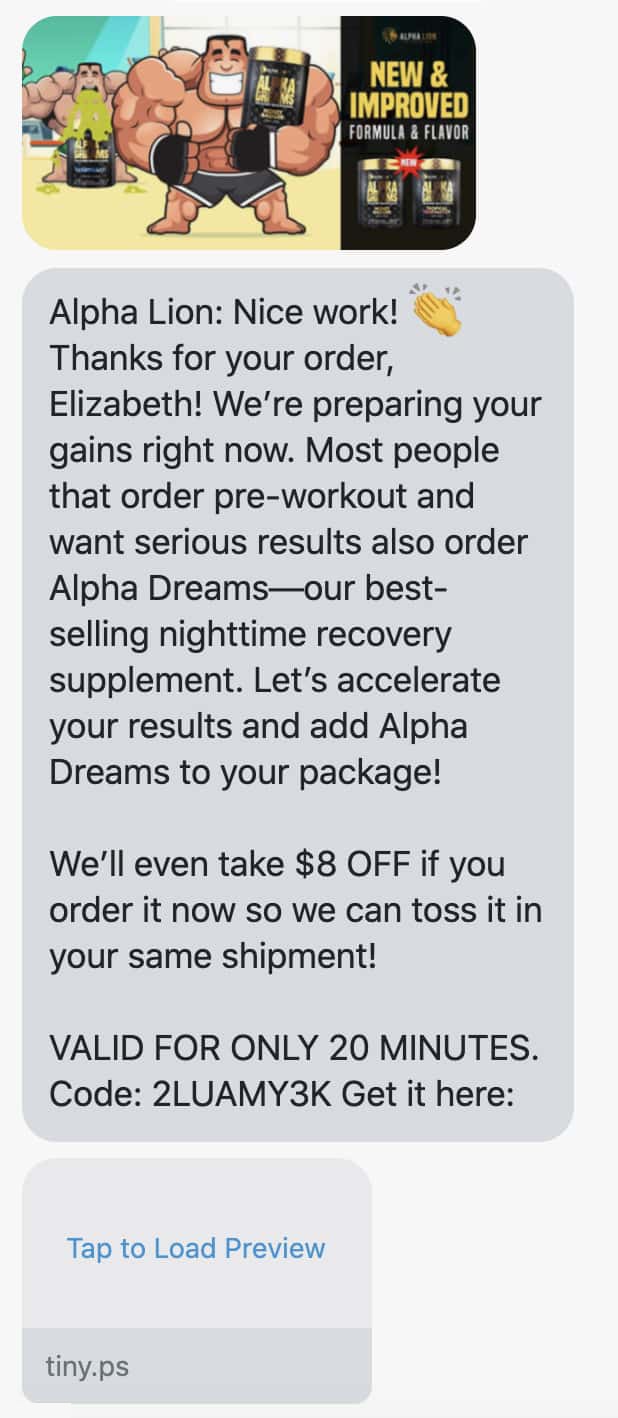
Alpha Lion sends this SMS to purchasers with a clear CTA that is valid for a limited time
Understand SMS Performance
Upon sending out your first few SMS campaigns and getting your automations set up, you’ll want to dig into their performance so you can continue to improve and understand what is working and not working for your brand.
To understand your SMS analytics and performance, you’ll want to monitor these metrics:
- Unsubscribe Rate: This is the number of subscribers who have opted out of receiving your SMS message. A good rule of thumb: This number should be between 1-2% on average
- Total Clicks: The total number of people that have clicked on your SMS links
- Unique Clicks: The different number of people who have clicked on a link
- Orders: How many orders can be attributed to SMS
- Revenue: The dollar value attributed to all SMS
- EPM: Earning per message
- ROAS: Return on advertising spend (measuring what you are investing vs. what you’re earning)
What “Good” ROI Looks Like
After you’ve sent a few campaigns and set up a few automations, you’re now faced with the data at hand. You’re likely wondering how your SMS marketing performance stacks up against other brands. Here’s how you should evaluate the success of your messages:
- Campaigns: For campaigns, you’ll want to look at the EPM (earning per message). If you find that EPM is trending up, it’s a good indicator that you’re on the right track for cadence and the types of content you’re sending. On the flip side, if EPM is trending down, you’ll want to segment more and send less per user.
- Unsubscribe Rate: If you see unsubscribes are trending up, you should send less content and change up the type of promotions that you’re sending. Trending down? Good work, keep the cadence and content the same.
Taking Your SMS Strategy a Step Further
Hopefully, this guide has provided you with a solid foundation to get started with your SMS marketing strategy. Building a new marketing channel can often be daunting and for that reason, if you seek to go further with your SMS marketing strategy, you can take the comprehensive SMS Marketing Certification.



